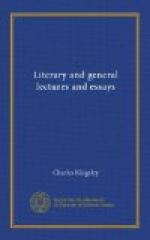But if so, what becomes of the theory which calls Pagan art by all manner of hard names? which dates the downfall of Christian art from the moment when painters first lent an eye to its pernicious seductions? How can those escape the charge of eclecticism, who, without going to the root-idea of Greek art, filched from its outside just as much as suited their purpose? And how, lastly, can M. Rio’s school of critics escape the charge of Manichean contempt for God’s world and man, not as ascetics have fancied him, but as God has made him, when they think it a sufficient condemnation of a picture to call it naturalistic; when they talk and act about art as if the domain of the beautiful were the devil’s kingdom, from which some few species of form and elements were to be stolen by Christian painters, and twisted from their original evil destination into the service of religion?
On the other hand, we owe much to those early ascetic painters; their works are a possession for ever. No future school of religious art will be able to rise to eminence without taking full cognisance of them, and learning from them their secret. They taught artists, and priests, and laymen too, that beauty is only worthy of admiration when it is the outward sacrament of the beauty of the soul within; they helped to deliver men from that idolatry to merely animal strength and loveliness into which they were in danger of falling in ferocious ages, and among the relics of Roman luxury; they asserted the superiority of the spirit over the flesh; according to their light, they were faithful preachers of the great Christian truth, that devoted faith, and not fierce self-will, is man’s glory. Well did their pictures tell to brutal peasant, and to still more brutal warrior, that God’s might was best shown forth, not in the elephantine pride of a Hercules, or the Titanic struggles of a Laocoon, but in the weakness of martyred women, and of warriors who were content meekly to endure shame and death, for the sake of Him who conquered by sufferings, and bore all human weaknesses; who “was led as a lamb to the slaughter, and, like a sheep dumb before the shearer, opened not his mouth.”
We must conclude with a few words on one point on which we differ somewhat from Mrs. Jameson—the allegoric origin of certain legendary stories. She calls the story of the fiend, under the form of a dragon, devouring St. Margaret, and then bursting at the sign of the cross while the saint escaped unhurt, “another form of the familiar allegory—the power of Sin overcome by the power of the Cross.”




